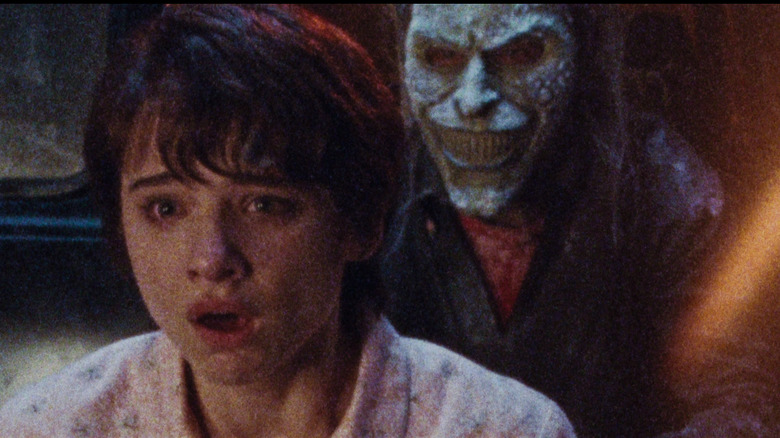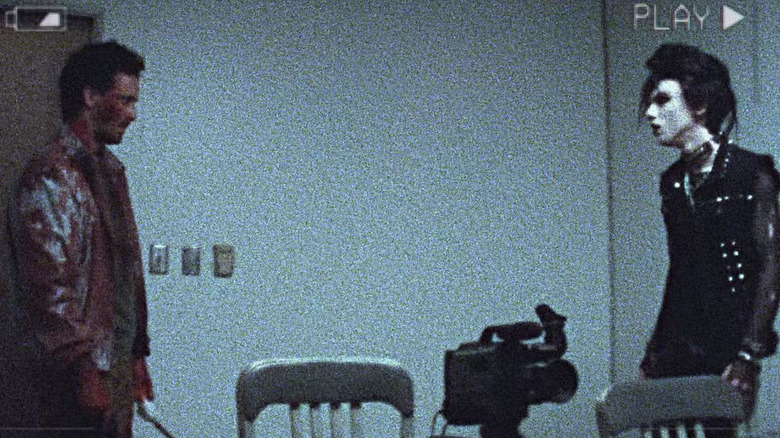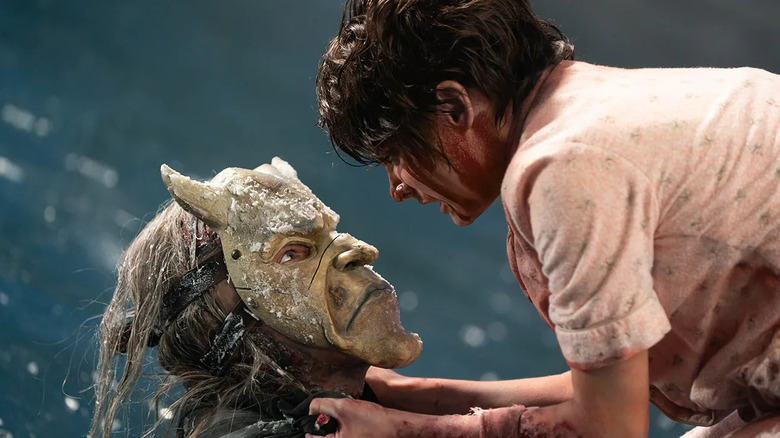Black Phone 2 Takes Place In Scott Derrickson's Secret Horror Universe
Director Scott Derrickson is not a stranger to sequels, per se, but he's also not one to indulge in them too often. To be sure, he began his career co-writing the sequel "Urban Legends: Final Cut" and then co-writing and directing "Hellraiser: Inferno," the fifth entry in that series, both in the same year. Ever since then, Derrickson's only been involved with one sequel, "Sinister 2," which he co-wrote and produced but did not direct. This weekend, "Black Phone 2" hits theaters, and it's the first fully-fledged Derrickson sequel: a movie that he has co-written and directed, which is a direct follow-up to "The Black Phone," a film that he also co-wrote and directed.
However, it so happens that "Black Phone 2" is not the only other film in the world of "The Black Phone." In "V/H/S/85," Derrickson and co-writer C. Robert Cargill contributed the segment entitled "Dreamkill," in which visions of several brutal murders are coming to a teenage boy in his dreams, which he's then able to somehow record to videotape. This supernatural psychic ability is highly similar to the one seen in "The Black Phone," and it turns out that the characters in each who have these gifts are related by blood. Thus, "Dreamkill" exists in the world of "The Black Phone," which means that Scott Derrickson has made a secret little horror cinematic universe all his own.
The 'Black Phone' reference in 'Dreamkill' you might've missed
Both "Black Phone" films revolve around siblings Finney (Mason Thames) and Gwen Blake (Madeleine McGraw), who live in North Denver, Colorado. In 1978, Finney is abducted by the serial killer known as The Grabber (Ethan Hawke), and Gwen helps rescue her brother thanks to her psychic dreams that give her clues to the whereabouts of the Grabber and his victims. In 1982, the Grabber finds a way to attack Gwen and Finney from the afterlife. "Dreamkill" takes place in 1985, several years after the events of "Black Phone 2," but was made between the two films. While there isn't an appearance by Finney, Gwen, or the Grabber, Derrickson and Cargill snuck in an easily missed moment that directly ties it to the "Black Phone" films. As Derrickson explained to ComicBook.com:
"Oh, there's actually a universe crossover in there, which I guess I made it too subtle because nobody's picking it up. James Ransone [as Bobby Blake] tells Detective Wayne, when he's behind the glass, he was talking about Gunther. He says, 'He has these dreams that are prophetic.' And he says, 'My sister had the same gift. They drove her crazy, she killed herself.' And he said, 'Gunther's cousin Gwen has the same thing too. I f***ing hate it.' Well, the sister is Gwen's mom, and Gwen is Gwen from 'The Black Phone.'"
Gunther Blake is the Gunther in question, and he's the teen with psychic powers in "Dreamkill." Another little Easter egg is that he's played by Dashiell Derrickson, Scott's real-life son. Though there's no mention of the Grabber or the ordeals of Finney and Gwen in "Dreamkill," there's no doubt that the Blakes are related, and thus all three films are part of the same universe.
Sinister may be part of the Derrickson/Cargill horror universe, too
It's a little early to definitively claim that there's a Derrickson/Cargill cinematic universe, but all three share the same eerie device. In the "Black Phone" films, Gwen's psychic dreams take the form of Super 8 film footage. The first movie uses this as a general aesthetic choice to make Gwen's visions feel unique, as well as further evoke the period nostalgia of the movie as a whole. Yet its extensive use in "Black Phone 2" is to help distinguish when Gwen is experiencing supernatural phenomena (such as a Grabber attack) in the real world as well as when she's having a premonitory dream. Thus, the use of Super 8 footage as a medium is an indication that something supernatural is going on.
This idea was initially developed in "Dreamkill," which makes a point to distinguish between Gunther's dreams/visions in Super 8 format and the "real world" footage, captured with early '80s, low-resolution VHS cameras. Again, this was initially purely for aesthetic purposes, as Derrickson explained to Bloody Disgusting:
"I started out of interest of being able to mess with the medium within the VHS found footage idea to try to push the boundaries of what could be done. I started with the idea of having Super 8 film footage on a VHS tape."
However, when all three films are taken as a whole, it becomes clear that the use of Super 8 footage is a direct indicator of supernatural happenings. Could Derrickson and Cargill's "Sinister," which also features Super 8 footage as a major element, be considered part of this universe? It's possible, if still unconfirmed. For now, just be wary of Super 8 in a Derrickson film, as it surely means something creepy is around the corner.


